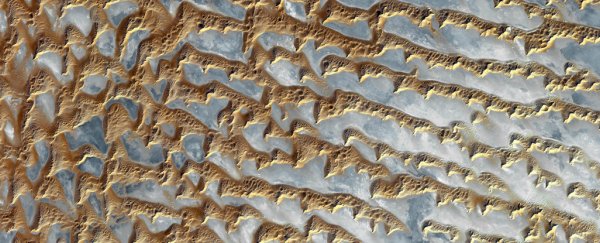Our new favourite place on Earth is a spectacular, shimmering ocean of sand called Rub' al Khali - or the Empty Quarter - which just so happens to be the planet's largest sand sea, spreading more than 660,000 square kilometres across the southern third of the Arabian Peninsula.
In terms of size, the Sahara Desert is 15 times larger, but while it's padded out by rocky terrain and gravelled plains, the Empty Quarter is nothing but treacherous sand dunes as far as the eye can see. In fact, the Empty Quarter contains around half the volume of all the sand in the Sahara.
Up close, it's a pretty tough environment, with little more than 3.5 cm of rain falling annually, temperatures averaging 50°C, and sand dunes towering up to 250 m tall. But when you look down on the desert from space it transforms into a glistening ocean:
For obvious reasons, the desert went unexplored by non-locals until the early 1930s, and since then, there have only been a handful of exploratory and scientific missions into the sand sea - also known as an 'erg'. A research expedition in 2006 revealed some native plant and bird species that have managed to thrive in the sand dunes.
Researchers also found evidence that the desert wasn't always so empty. As recently as 300 AD, the region was a regular route for trade caravans, with fossilised remains of hippopotamus, water buffalo and long-horned cattle suggesting that the desert was once far less arid.
So how did that enormous desert form? There are two main hypotheses for the original source of the sand, with one suggesting that the sand was gradually exposed as the Persian Gulf receded over millions of years of ice ages and thawing, and then eventually blew across to the Empty Quarter. But other researchers suggest that the pinkish colour of the sand indicates iron oxide content, which means it may have been carried across to the Empty Quarter by seasonal streams.
And once the sand got there, it struggled to leave, as Mika McKinnon explains for io9:
"The erg lays within a structural basin, a geological recess surrounded by wind-blocking obstructions that trap sand no matter how long the wind blows. The basin is tilted, with the thinnest sheet of fine, soft sand in the west where the elevation is highest, and a thick mantle of sand that supports dunes and salt flats in the lower-elevation east."
This combination of winds and endless sand has led to a mix of crescent-peaked barchan dunes; small, pretty star-shaped dunes; pyramidal domal dunes; and the straight longitudinal dunes that you can see in the breathtaking images below. The mirror-like patches between the dunes are huge salt flats that reflect the sunlight above. See more over at io9.
 NASA/GSFC/METI/ERSDAC/JAROS, and U.S./Japan ASTER Science Team
NASA/GSFC/METI/ERSDAC/JAROS, and U.S./Japan ASTER Science Team



